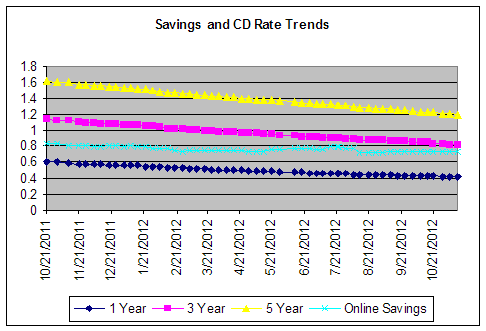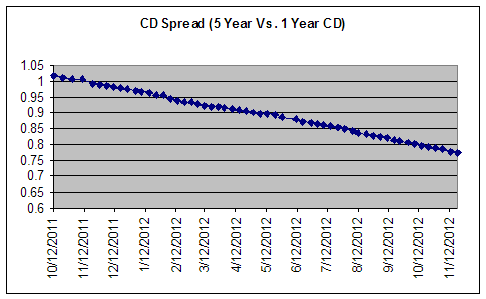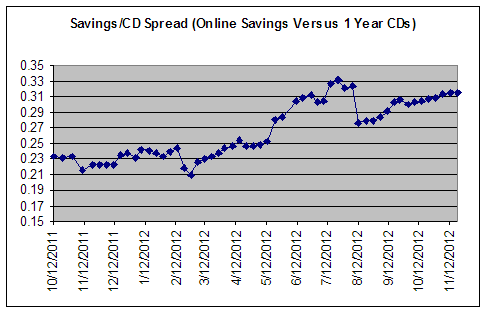The downward trend continues with CD rate averages falling again in the previous week. The one year CD average fell from .417% to .414% APY. Five year average CDs fared even worse falling from 1.194% APY to 1.185% APY. Online savings rates were a bright spot with the average rising from .731% to .733% APY. Online savings and money market rates have remained relatively firm this year in comparison to CD rates as the chart below shows.
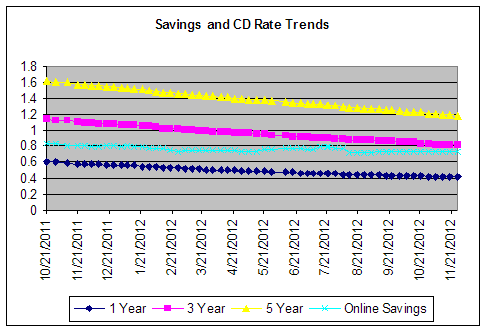
Holiday Shopping Starts Off with a Bang
The National Retail Federation said Sunday that a record 89 million people shopped either online or in stores this past holiday weekend. That's up from 86 million last year. The shoppers spent on average $423 this weekend versus $398 last year. This adds another positive data point to the recent spate of news that the economy may be gaining some life (other good news included gains in housing and consumer confidence). If strong consumer spending materializes over the next month, it will provide more support for increased economic growth.
The economy now needs to navigate the fiscal cliff and figure out how to put the millions of unemployed back to work. Once the unemployment rate dips below 7% savers can begin to think about rising interest rates..
My outlook: Savings rates will continue to drift lower for the next 12-18 months before beginning to move higher. How high and how fast they move will depend on the government's ability to put a long-term budget deal in place, the continuation of a recent economic uptick, and the ability of Europe to put its woes behind it and resolve its fiscal problems.
So, what's a saver to do in this environment?
Savings Options
Should a saver open a savings account or a CD? A shorter-term CD or a longer one? The chart below shows the comparison between the yield of a 5-year CD and a 1-year CD. Notice that this difference has shrunk considerably over the past year as the yield on 5-year CDs has dropped by more than the yield on a 12-month CD. This drop continued last week.
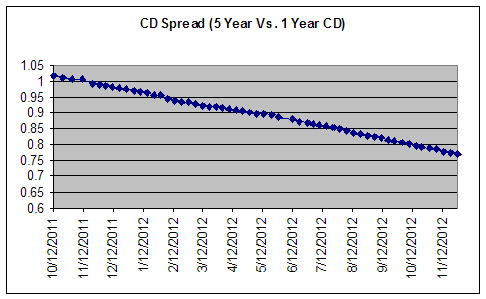
Not much has changed with the various product spreads. While the spread started the year at 1% or 100 basis points, it is now .771%. As a comparison, in 2008, this spread stood at .43% while in 2010 it went as high as 1.56%. So right now, it's somewhere in the middle. Why does this matter? Because back in 2010 banks were paying a saver a lot more to invest in a 5 year CD versus a 1 year. Today, banks are giving about half the premium they did a few years ago to lock up your money for 5 years. In 2012, I advised savers to consider investing in 5-year CDs because of this premium: the economy looked stuck for quite some time, and inflation did not appear to be a problem. Now, with the premium down, and the economy growing (albeit not that fast) it's a bit of a harder case to make. If the government takes the economy over the fiscal cliff, then it makes sense to put money in longer-term CDs as the potential for another recession becomes much higher. If a compromise can be reached, I'd invest in shorter-term CDs. Consumers might want to consider laddering their CD portfolio in this rate environment.
What about the comparison between savings and CDs?
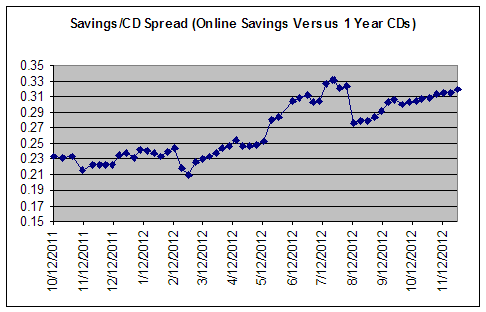
This spread has actually been growing. Online savings rates have, for the most part, maintained their rates while CD rates continue to fall. For short term savings, it appears to make more sense to park money in an online savings account versus a CD. Online savings accounts have remained very stable over the past year.
Make the best of a tough savings situation
For now though, savers can make the best of a tough situation by getting the very best rates on their money. Remember, even in today's environment, there is competition for your cash.
I hope this is helpful. If it is, let me know and I'll keep writing. Drop me a note or post a comment below.
Hope you find some good deals in your Holiday shopping! Until next week...

